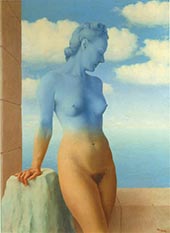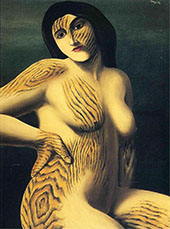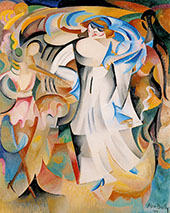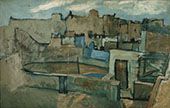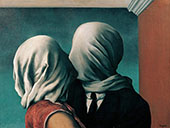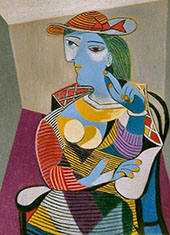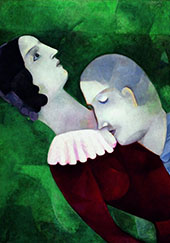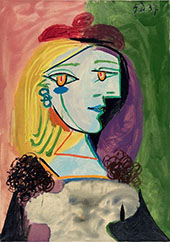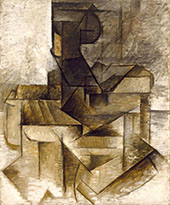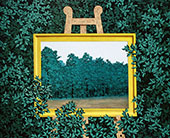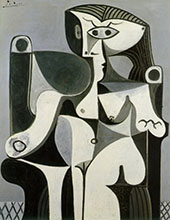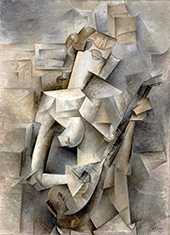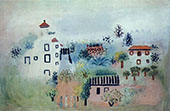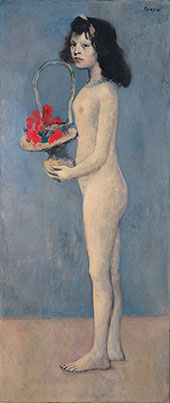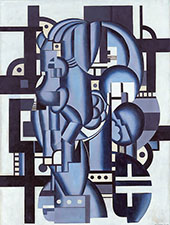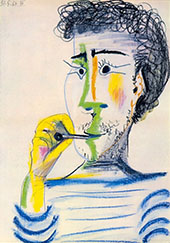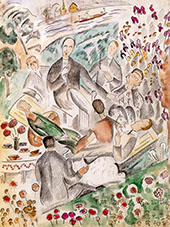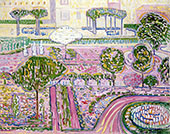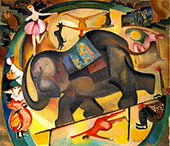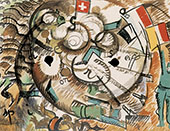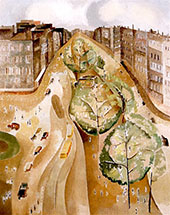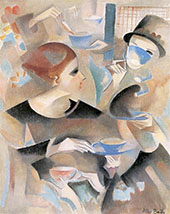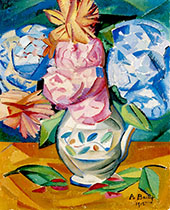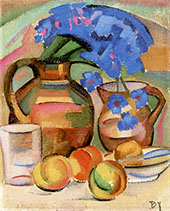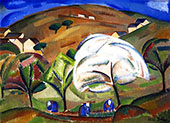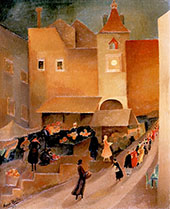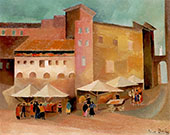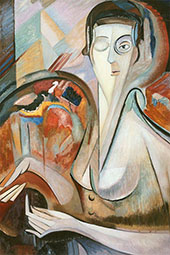Cubism Painting Oil Painting Reproductions
Find Cubism Painting Oil Painting Replicas By Cubism Artists
Cubist Art: A Brief Introduction
Cubism painting and the Cubist art movement are pioneering developments of 20th century art. This art movement is one of the best-known artistic styles, lasting from approximately 1900-1920. This brief introduction answers some of the most commonly asked questions about this iconic style, from defining Cubism paintings and their distinct phases to key founders and their most famous paintings.
What is Cubism in simple terms?
In the simplest terms, cubist art refers to art that breaks natural forms into geometric shapes, which helps provide many different perspectives and ways of looking at art and the objects it represents. The cubist art movement was developed in the early 1900s and attempted to present objects simultaneously from multiple angles.
The innovative approach of Cubism Painting brought a significant shift in the perception of art and painting. It encompassed painting and influenced sculpture, collage, architecture, poetry, and music.
Three distinct styles of Cubism Painting?
Cubist art progressed in three main phases: Cezanian Cubism, Analytic Cubism, and Synthetic Cubism. Despite adhering to fundamental principles of cubism, every style possesses distinctive attributes.
- Cezanian Cubism, This is generally referred to as “early cubism and involves breaking objects into basic geometric shapes. Ir uses cylinders and spheres, along with cubes and cones. As the name suggests, Paul Cezanne paintings are very influential.
- Analytical Cubism: The style of Analytical Cubism focuses on breaking down objects into smaller parts, with a particular emphasis on rectangular shapes and overlapping planes. The goal is to "analyze" the objects, which is why artists use a limited color palette to draw attention to the shapes.
- Synthetic Cubism: emerged post 1912. Geometric shapes and a broader and brighter color palette define it.
Who are the founders of the Cubism Art Movement?
Cubism was founded and developed by Pablo Picasso and George Braque, who believed that artists should not limit themselves to realistic depictions of subjects or decorative art. They aimed to represent every part of a subject in their paintings. The two artists drew inspiration from various art forms, such as African masks with their geometric shapes and exaggerated features, Egyptian paintings that depicted multiple moments in time, and the emerging field of Abstract Art. Their innovative approaches to painting transformed the art world and left a lasting impact on modern art. In turn, the astoundingly creative artwork of both Picasso and Braque influenced a generation of later artists.
Who was the most famous Cubist Artist?
Pablo Picasso was the most famous cubist painter. As an obscure Spanish artist residing in France, he tested different concepts and hypotheses. Picasso's initial paintings were heavily realistic and lifelike in their appearance. However, this changed after he met Henri Matisse. Fauvist paintings inspired Picasso to create his groundbreaking art, sparking a competitive relationship that revolutionized the European art scene.
Picasso’s Cubism started around 1907, and he created some of the most famous Cubist art during his lengthy career. In addition, he drove the movement forward both artistically and intellectually. Following the upheavals of World War One, Picasso abandoned a strictly cubist aesthetic. He instead focused on Neoclassicism art during the late 1910s and 1920s, which allowed a “return to order.”
Which three artists are most famous for Cubism Paintings?
The three artists most famous for Cubism are Pablo Picasso, George Braque, and Juan Gris.
Pablo Picasso (1881-1973)
Pablo Picasso’s cubist art began with Les Demoiselles d’Avignon in 1907. Despite the initial poor critical reaction to this now-famous Picasso painting, the artist devoted himself to this innovative approach.
He pioneered Cubism alongside his friend George Braque. Both artists often used monochrome neutral color palettes (although Picasso soon moved to more colorful paintings). Together they analyzed objects and people alike, exemplified in works such as Girl with Mandolin (1910).
Picasso’s cubist art developed throughout the 1910s. He sometimes used cut paper fragments in his paintings. These fragments often included newspaper and wallpaper. This was the first example of collage in Western art.
His paintings from 1915-1917, such as Man with a Pipe, are characterized by highly geometric and minimal compositions. Common features in these paintings include pipes, guitars, and glasses. Coined shortly after, the term Crystal Cubism defines these complex and modern art paintings.
Georges Braque (1882-1963)
As well as a vital role in the development of Cubism, George Braque also instigated the Fauvism approach. Between 1908 and 1912, he frequently collaborated with Pablo Picasso. As a result, their cubist paintings were often almost identical.
Despite the similarity in their approach, Picasso’s fame quickly eclipsed that of George Braque. George Braque paintings are often quieter and more heavily influenced by Paul Cezanne. Braque's early bucolic paintings, such as Houses Estaque (1908), illustrate the similarity.
This painting represents Braque’s technique of reducing architecture to elementary geometry. He shaded objects so they looked simultaneously flat and 3-D. Investigations into simultaneous perspectives and movement in time developed into later works, such as Bird Passing through a Cloud from 1957. This work was particularly intriguing.
Juan Gris (1887-1927)
Juan Gris paintings are among Cubism’s most distinctive creations. Like Picasso, he was a Spanish artist who lived and worked in France for much of his life. Moving to Paris in 1906, he initially worked on humorous magazine illustrations.
Gris began painting seriously in 1911 and immediately adopted a cubist style. Indeed, he coined the term Analytical Cubism. Juan Gris' technique is evident in his 1912 painting, Portrait of Picasso. He also painted unusual landscapes, such as Landscape with Houses at Ceret in 1913.
Moving quickly to a synthetic style, Gris believed in the importance of mathematics in painting. As a result, he frequently adopted grid structures, broken apart with triangular and diagonal forms.
Who are the leading Cubism Artists?
Like Picasso, Braque, and Gris, other famous Cubist artists include Fernand Leger, Paul Klee, Jean Metzinger, and Albert Gleizes. Fernand Leger paintings, such as Three Women or Le Grand Dejeuner 1921, represent the later cubist art approach.
The women’s bodies consist of spheres and sharply angled forms, making them seem part-machine, part human. Indeed, the careful shading is heavily reminiscent of metal, with the women gazing unswervingly at the viewer. In addition, the slanted, dazzling floor patterns further evoke a strongly cubist approach to broken perspective and space.
Paul Klee paintings, such as Senecio 1922 and Castle and Sun 1928, also demonstrate the fascinating development of later cubism paintings. Both paintings show cubist flat planes of color re-combining with figurative and symbolic approaches.
What is the most famous Cubism oil painting?
The most famous Cubist painting is Picasso’s Les Demoiselles d’Avignon 1907, which is known as the first Cubist painting. Louis Vauxcelles, a French Art critic, coined the term "bizarreries cubiques" in 1908. This was the first time the Cubism art movement was given a name.
Picasso painted Les Demoiselles d’Avignon over nine months. Picasso was inspired by famous bather paintings from Africa and Spain's "primitive" art. These included Dominique Ingres's paintings and Henri Matisse's painting Joy of Life.
Critics and the art public could have received the painting better. Many were shocked by Picasso’s abstract presentation of women’s naked bodies. George Braque commented on the fragmented faces of the women in Picasso's work. He said it was like Picasso "gave us oil to drink to spit fire."
What is the most famous Cubist artwork?
As well as oil paintings, many cubist artists, including Picasso, created cubist sculptures. Architects utilized its principles to construct buildings, and poets experimented with breaking apart traditional forms of the written word.
Consequently, the most famous Cubism art form is arguably Woman’s Head, Fernande, by Pablo Picasso. Created in 1909, this piece of cubist art depicted his lover, Fernande Olivier.
It’s a striking creation initially formed from clay and later cast in Bronze, with Picasso’s explicit permission. Like cubist paintings, the sculpture consists of various planes and uses simple geometric forms. As well as a famous object, it’s an example of the enormous diversity of cubist art.
The sculpture aims at presenting multiple aspects of the woman simultaneously. From one viewpoint, it appears to change shape and meaning. This is similar to a person moving through time and space.
Cubist oil painting reproductions
If you love the energy and dynamism of cubist painting, explore our extensive collection of fine art reproductions.
Buy modern wall art by famous artists Juan Gris, Paul Klee, George Braque, and Fernand Leger.
Cannot Find What You Are Looking For?
Reproduction Gallery Information
Customer Service
(Send Us A Message)
Tel: (503) 937 2010
Fax: (503) 937 2011

